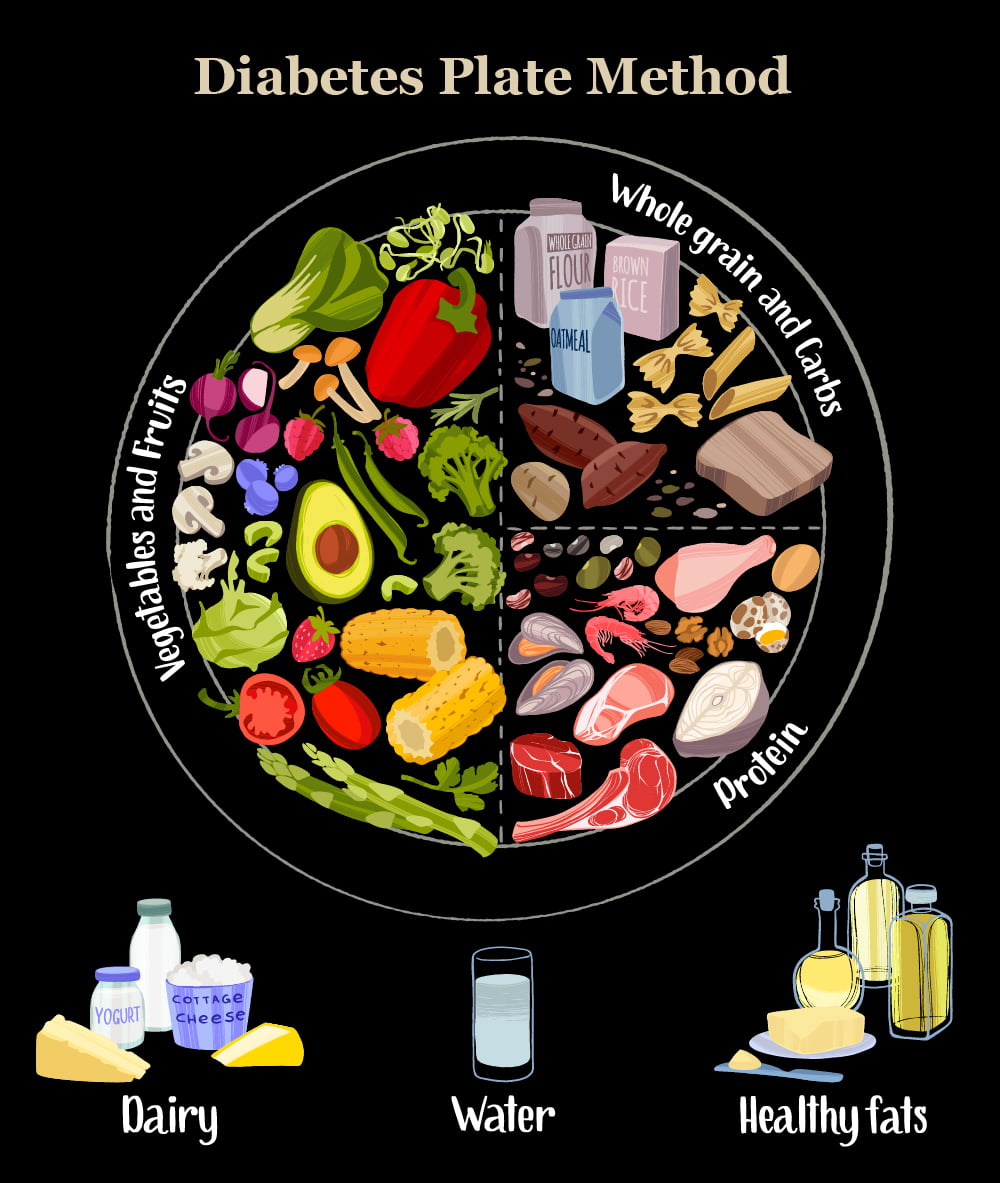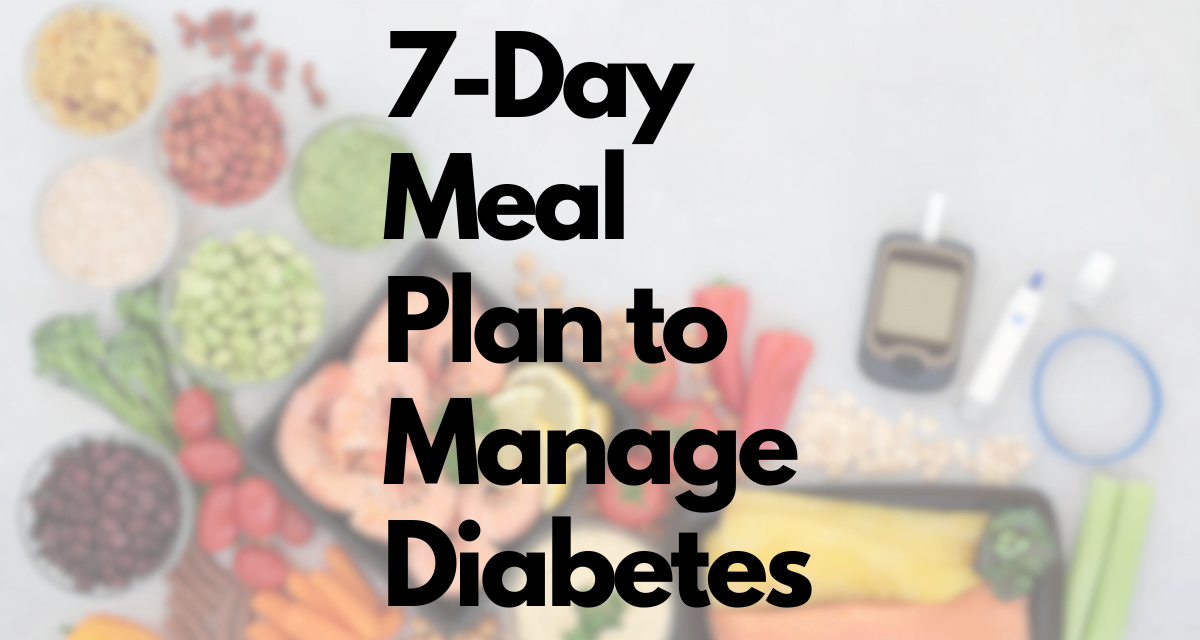A 7-day meal plan can be a helpful tool for people with diabetes to manage their blood sugar levels and overall health.
Diet is essential in managing diabetes, regardless of whether you have type 1 or 2 diabetes. By following a plan that includes the right foods and portion sizes, people with diabetes can reduce their risk of complications and improve their quality of life.
Many different 7-day meal plans are available, so it is important to find one that fits your individual needs and preferences—factors to consider are your blood sugar goals, your activity level, and your food allergies or intolerances.
The American Diabetes Association (ADA) has recommended guidelines for how to eat daily to help you manage your glucose levels. These guidelines include:
- Choosing healthy carbohydrates: Carbohydrates are the main nutrient that affects blood sugar levels, so it is important to choose healthy carbohydrates. Healthy carbohydrates include whole grains, fruits, and vegetables. These foods are digested slowly and do not cause blood sugar levels to rise as quickly as unhealthy carbohydrates, such as sugary drinks and processed foods.
- Eating regular meals and snacks: Eating regular meals and snacks helps to keep blood sugar levels stable throughout the day. Eating meals and snacks that are balanced and contain a mix of carbohydrates, protein, and fat is important.
- Set a timer: Setting a 2.5-hour timer to remind yourself to have a snack and maintain optimal blood sugar levels. Don't wait until you feel bad, but plan ahead and be proactive.
- Monitoring your blood sugar: It is important to monitor your blood sugar regularly to see how your food choices affect your blood sugar levels and helps you to make adjustments to your diet as needed.
- Another useful tip: Establish specific times to monitor your blood sugar levels and become aware of the activities that might require a blood sugar check.
Here are three considerations in your meal planning:
- Your individual needs: Everyone’s nutritional needs are unique, so consider your individual needs when planning your meals. Take into factors such as age, activity level, and overall health.
- Your preferences:It is important to consider your choices when planning your meals. By choosing foods you enjoy and are likely to stick with.
- Your lifestyle: Your lifestyle also plays a role in your meal planning. If you are busy or on the go a lot, you may need to choose foods that are easy to prepare or that you can take with you.
Know Your Carbohydrates
Carbohydrates are a major source of energy for the body, but they can also have a big impact on blood sugar levels. For people with diabetes, it’s important to be mindful of their carbohydrate intake and choose foods that will help them maintain stable blood sugar levels.
There are three main types of carbohydrates: fiber, starch, and sugar.
Fiber is a carbohydrate that the body cannot digest because it does not break into a sugar molecule. But it helps keep you full and satisfied and can also help lower cholesterol levels. Good sources of fiber include fruits, vegetables, whole grains, and legumes.
Starch is a carbohydrate that breaks into glucose during digestion. It is a good energy source but can cause blood sugar levels to rise quickly. Good sources of starch include bread, pasta, rice, and potatoes.
- Sugar is a type of carbohydrate that is quickly digested and absorbed into the bloodstream. It can cause blood sugar levels to rise quickly, like candy, soda, and pastries.
When choosing carbohydrates, it is important to consider the food's glycemic index (GI). The GI measures how quickly food raises blood sugar levels. Foods with a high GI will cause blood sugar levels to rise quickly, whole foods with a low GI will cause blood sugar levels to rise more slowly.
In general, people with diabetes should choose foods with a low GI. These foods include:
- Whole grains
- Fruits
- Vegetables
- Legumes
- Nuts
- Seeds
Diabetes Plate Method
The Diabetes Plate Method is a helpful way to plan healthy meals for people with diabetes. It is a simple and easy-to-remember way to ensure that you are getting the right balance of nutrients in your meals.
The Diabetes Plate Method divides your plate into three sections:
- Non-starchy vegetables: These should make up half of your plate. Non-starchy vegetables are low in calories and carbohydrates and high in fiber. They are also a good source of vitamins, minerals, and antioxidants.
- Lean protein:This should make up a quarter of your plate. Lean protein is low in fat and calories and a good source of protein. Protein helps to keep you feeling full, and it can help to regulate your blood sugar levels.
- Carbohydrates:This should make up the remaining quarter of your plate. Carbohydrates are a major source of energy, and they are also a good source of fiber. However, choosing carbohydrates that are high in fiber and low in sugar is important.

The Diabetes Plate Method is a flexible guideline, and you can adjust it to fit your individual needs and preferences. For example, if you are trying to lose weight, you may want to increase the amount of non-starchy vegetables on your plate and decrease the amount of carbohydrates. Or, if you are an active person, you may need to increase the amount of protein on your plate.
The key to the Diabetes Plate Method is to focus on eating a variety of healthy foods from all of the food groups. This will help you to get the nutrients you need to stay healthy and manage your diabetes.
Diabetic Meal Planning "Create your plate" 6 easy steps
Lifestyle Considerations
Lifestyle considerations are an important part of managing diabetes. In addition to diet and exercise, a few other lifestyle factors can help you manage your diabetes.
Stress can lead to high blood sugar levels, so find ways to manage stress. Some helpful strategies include yoga, meditation, and deep breathing exercises.
Getting enough sleep is essential for overall health and is also important for people with diabetes. When you don’t get enough sleep, your body produces more stress hormones, which can lead to high blood sugar levels. Aim for 7-8 hours of sleep each night.
If you are overweight or obese, losing even a small amount of weight can help improve your blood sugar control. Talk to your doctor about a safe and effective weight loss plan for you.
Smoking damages your blood vessels and makes it harder for your body to use insulin. If you smoke, quitting is one of the best things you can do for your health.
Alcohol can raise your blood sugar levels, especially if you drink too much. If you choose to drink alcohol, do so in moderation.
By making lifestyle changes, you can improve your blood sugar control and reduce your risk of complications from diabetes.
Here are some additional tips for managing diabetes through lifestyle changes, see your doctor regularly, get involved in a diabetes support group, and continue to learn about diabetes.
Your doctor can help you track your blood sugar levels and ensure your treatment plan works. Talking to other people who have diabetes can be helpful and supportive.
The more you know about diabetes, the better equipped you will be to manage it. There are many resources available to help you learn about diabetes, including books, websites, and support groups.
The integrated healthcare clinics Axis offer diabetes education and nutrition programs. These programs can be a great way to learn about diabetes and how to manage it. Certified diabetes educators can teach you about various topics related to diabetes, from how it affects your body to lifestyle management. They can also help you develop a personalized treatment plan that meets your needs.
Managing diabetes can be challenging, but it is possible. By making lifestyle changes and working with your doctor, you can live a long, healthy life with diabetes.


